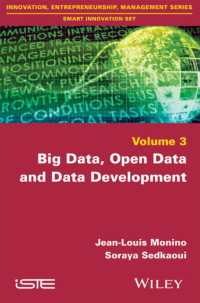- ホーム
- > 洋書
- > 英文書
- > Science / Mathematics
Full Description
The Application of Probability Theory is a comprehensive book that explores the diverse applications of probability theory across various fields, ranging from statistics and data analysis to machine learning and artificial intelligence, medical and health sciences, natural language processing, information retrieval, and engineering. The book delves into the fundamental principles and concepts of probability theory, such as sample space, events, probability distribution, random variables, probability laws, and expected value, and highlights the distinctions between frequentist and Bayesian approaches. With a collection of contemporaneous articles, it presents cutting-edge research and practical examples that showcase the relevance and impact of probability theory in understanding uncertainty, making predictions, assessing risks, designing experiments, and conducting statistical inference. Whether it's developing statistical models for missing data, enhancing machine learning algorithms with probability information, optimizing clinical trial designs for Alzheimer's disease, predicting urinary tract infections, or detecting fake news and hate speech, this book serves as a valuable resource for researchers, practitioners, and students seeking a deeper understanding of the applications of probability theory in today's rapidly evolving world.
Contents
Chapter 1 Introduction
Chapter 2 Missing Data Approaches for Probability Regression Models with Missing Outcomes with Applications
Chapter 3 Maximum Likelihood Estimation for Three-Parameter Weibull Distribution Using Evolutionary Strategy
Chapter 4 Probability Distribution and Deviation Information Fusion Driven Support Vector Regression Model and its Application
Chapter 5 Cascade Source Inference in Networks: a Markov Chain Monte Carlo Approach
Chapter 6 PICF-LDA: A Topic Enhanced LDA with Probability Incremental Correction Factor for Web API Service Clustering
Chapter 7 The Development of a Stochastic Mathematical Model of Alzheimer's Disease to Help Improve the Design of Clinical Trials of Potential Treatments
Chapter 8 Comparison of Neural Network and Logistic Regression Analysis to Predict the Probability of Urinary Tract Infection Caused by Cystoscopy
Chapter 9 Statistical Analysis of Orthographic and Phonemic Language Corpus for Word-Based and Phoneme-Based Polish Language Modelling
Chapter 10 Detection of Fake News and Hate Speech for Ethiopian Languages: A Systematic Review of the Approaches
Chapter 11 Comparison between the Hamiltonian Monte Carlo Method and the Metropolis-Hastings Method for Coseismic Fault Model Estimation
Chapter 12 Sequential Monte Carlo Method Toward Online RUL Assessment with Applications
Chapter 13 Probabilistic Forecasting of Traffic Flow Using Multikernel Based Extreme Learning Machine
Chapter 14 Value-at-Risk under Ambiguity Aversion
Chapter 15 DAViS: A Unified Solution for Data Collection, Analyzation, and Visualization in Real-Time Stock Market Prediction








